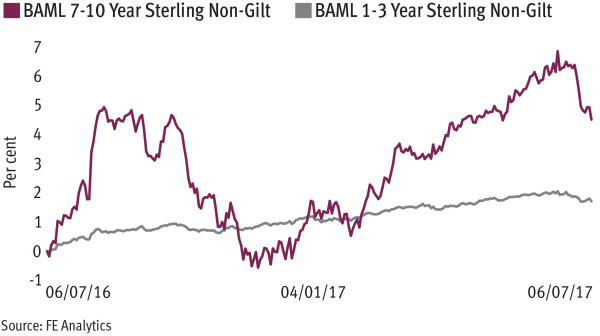

Falling yields, coupled with expectations of higher global growth and inflation, led many to believe that the bond sell-off would begin in earnest in 2017. The assumption was supported by a spike in yields in the second half of 2016, but fixed income has rallied again this year.
As a result, short-duration strategies have underperformed conventional peers both year to date and on a 12-month view, with those exposed to such funds experiencing weaker returns as a result.
Ten-year gilt yields have fallen from 1.96 per cent to 1.32 over the past 18 months, while the two-year yield has fallen from 0.65 to 0.37 per cent.
Columbia Threadneedle manager Maya Bhandari, whose portfolios have tended to favour a shorter duration stance, has admitted not holding conventional interest rate risk was an “opportunity lost”.
The UK corporate bond benchmark duration is around 8.5 years. However, Ms Bhandari said the current 1.3 years duration position in the Threadneedle Dynamic Real Return fund was more justifiable now than when it was first implemented.
“It was an opportunity lost to not have more duration-bearing assets in the past year,” she said.
“But sitting where we’re sitting, and central banks sounding more hawkish, means that in terms of risk and reward the duration we have is one we want to hold. The valuation argument against duration is stronger, and the reasons for tightening from a fundamental perspective have increased.”
Whitechurch Securities managing director Gavin Haynes, whose firm invested in a Royal London Asset Management (RLAM) short-duration high-yield fund in the second half of 2016, said it was a sensible move.
“Although we don’t see rates rising dramatically, we believe a move towards tighter monetary policy means it is [still] prudent to be focused towards the shorter end of the curve,” he said.
Over 12 months the BofA Merrill Lynch 1-3 Sterling Non-Gilt index is up 1.7 per cent compared with a 4.5 per cent rise for the seven to 10-year equivalent index. Year to date the longer-duration index has outperformed by 2.2 percentage points, even when accounting for the sell-off seen since the end of June.
Andrew Gilbert, investment manager at Parmenion, was more critical of managers and other fund buyers for making “popular” moves into shorter-dated instruments. The firm’s bond exposure has a duration of five to six years, only slightly below its benchmark.
Mr Gilbert said yields would not spike but gradually rise, based on assumptions that the UK base rate would sit at around 3 per cent in 10 years’ time. He predicted any market shocks would be impossible to time, meaning extreme duration calls were best avoided.
“A lot of people really struggle to make that [timing] call and the ones that did have got it wrong,” he added.
The greater appetite for short-duration strategies has been matched by a flurry of product launches. RLAM was joined by Morgan Stanley, Kames, Fidelity, Standard Life Investments, Aberdeen, Canada Life Investments and Axa Investment Managers in launching such funds over the past 18 months.
Mr Gilbert said: “We didn’t fall into the trap. We are cognisant that you could have made a call of going short interest rate risk and that would have really hurt client portfolios, even though it was justified logically.”
KEY NUMBERS
£1.5bn
Assets in short duration strategies launched since 2016
2.2ppt
Outperformance of seven to 10-year debt compared with one to three years since January 2017



